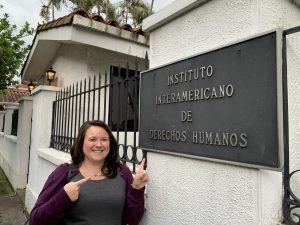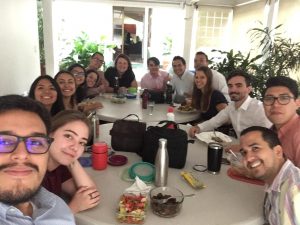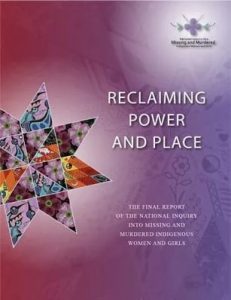My internship at the Inter-American Court of Human Rights is now almost over… time flies! In the time since my last post, I have had the chance to get to know even more colleagues from different countries around the Americas and overseas and to think about some of the most pressing human rights issues facing this region, as well as to deepen my reflection of Canada’s relationship with this institution.
One of my favourite parts of this internship has been the opportunity to participate in the rich academic life of the Court and neighbouring institutions. San José has become a hub of human rights law in the Americas, and interns at the Court have been invited to participate in lots of interesting talks inside and outside the Court. I went to a talk about the place of social, economic, and cultural rights in the Inter-American system at the Inter-American Institute for Human Rights. I also went to a talk about Costa Rica’s asylum policy at the University of Costa Rica’s Law Faculty.

Despite these enriching experiences, some of the best talks I’ve had have been with other interns as well as the Court’s lawyers over the lunch table. I love that it is part of the organizational culture here for everyone to take a break from their desks in the middle of the day to eat with colleagues. In these lunchtime chats, the interns and visiting professionals really get the chance to get to know each other and to learn about each other’s countries. Our topics cover everything from favourite dishes, to constitutional law, to the most important human rights issues.
On June 3rd the Final Report of the National Inquiry into Missing and Murdered Indigenous Women and Girls was released, and I mentioned it at lunch that day. The reaction was split: some lawyers knew of Canada’s poor track record in treatment of Indigenous peoples, but others could not believe their ears. “Missing and murdered Indigenous women, in Canada?” they asked me. The word “missing” in Spanish – desaparecido or desaparecida – comes with a lot of baggage.

In Latin America, the word “disappeared” is most commonly used to refer to people who have been forcibly disappeared by state actors in the context of authoritarian governments. Forced disappearance can happen in any part of the world, but its widespread use in Latin America has made it a common topic at the Inter-American Court.[i] Indeed, the Court’s development of the legal concept of forced disappearance, from its very first case in 1988,[ii] has been one of its most groundbreaking bodies of jurisprudence. For example, in the case Radilla Pacheco Vs. México, the Court explains that:
In International Law this Tribunals’ jurisprudence has been precursor of the consolidation of a comprehensive perspective of the gravity and continued or permanent and autonomous nature of the figure of forced disappearance of persons. The Court has reiterated that it constitutes a multiple violation of several rights protected by the American Convention and places the victim in a state of complete defenselessness, implying other related violations, especially grave when it forms part of a systematic pattern or practice applied or tolerated by the State.[iii]
In the same case the Court outlines the main components of forced disappearance, which have been developed through jurisprudential developments since 1988:
a) the deprivation of freedom; b) the direct intervention of state agents or their acquiescence, and c) the refusal to acknowledge the arrest and reveal the fate or whereabouts of the interested person.[iv]
Now, no one is suggesting that the crisis of missing and murdered Indigenous women and girls in Canada can be attributed to the “direct intervention of state agents” as outlined in Radilla Pacheco and other cases. However, the Court’s jurisprudence has expanded beyond disappearance by state agents and has examined disappearances committed by non-state actors. I think that these cases could teach some important lessons to Canada and Canadian courts for responding to the Final Report of the National Inquiry.
For example, the Court has said that state parties to the American Convention on Human Rights have the obligation to guarantee respect for the rights contained in that instrument and to prevent such violations. One part of the need to prevent and guarantee is to diligently investigate human rights violations, regardless of whether the suspected perpetrators are state agents or private individuals. The Court has also identified that states have an accentuated obligation of due diligence in the investigation of disappearances of people who have an accentuated risk of being victimized, including women.
One of the first such cases was the Case of González et al. (“Cotton Field”) v. Mexico (“Campo Algodonero” in Spanish), which deals with a situation of missing and murdered women in Ciudad Juárez in Mexico. The decision jointly analyses violations of rights contained in the American Convention and the Inter-American Convention on the Prevention, Punishment, and Eradication of Violence against Women, known as the Convention of Belém do Pará, of which Canada is also not a signatory. The Court said:
States should adopt comprehensive measures to comply with due diligence in cases of violence against women. In particular, they should have an appropriate legal framework for protection that is enforced effectively, and prevention policies and practices that allow effective measures to be taken in response to the respective complaints. The prevention strategy should also be comprehensive; in other words, it should prevent the risk factors and, at the same time, strengthen the institutions that can provide an effective response in cases of violence against women. Furthermore, the State should adopt preventive measures in specific cases in which it is evident that certain women and girls may be victims of violence. This should take into account that, in cases of violence against women, the States also have the general obligation established in the American Convention, an obligation reinforced since the Convention of Belém do Pará came into force. (emphasis mine)[v]
The Court has also established that States must adopt norms and regulations that allow the authorities to investigate cases of violence against women with the required due diligence. It has suggested that the state can satisfy this requirement through the standardization of protocols, manuals, and expert consulting and judicial services.[vi]

In comparing IACtHR jurisprudence with Final Report of the National Inquiry, I saw an overlap between types of problems identified in cases like Campo Algodonero and the challenges faced by Indigenous Women, Girls, members of the LGBTQ2S community, and their families. The National Inquiry reports descriptions of “police apathy in cases involving violence against Indigenous women, girls, and 2SLGBTQQIA people”, mentioning that this apathy “often takes the form of stereotyping and victim-blaming, such as when police describe missing loved ones as ‘drunks,’ ‘runaways out partying,’ or ‘prostitutes unworthy of follow-up.’”[vii] However, police services are not the only problem. When the National Inquiry spoke to police services, many cited “insufficient equipment and resources as impeding their efforts to engage in proper investigation, as well as in crime prevention, in First Nations communities.”[viii] It is easy to make the connection between the gaps revealed in the report and the standards called for by the Inter-American Court.
The more I learn about the Inter-American Human Rights System, the more I realize that Canada shares a lot of struggles with Latin American countries. Indeed, a history of colonization and genocide of Indigenous peoples is common to almost every country in the Americas, including Canada and the United States. One could say it’s what brings us together and unites us, our common legacy of colonization.
The Canadian government and Canadian courts should look to the rich jurisprudence of the Inter-American Court for inspiration on how to tackle the problems outlined in the National Inquiry’s Final Report. Although Canada is not a signatory of neither the American Convention nor the Convention of Belém do Pará, human rights are universal and the developments in this regional system could inspire and inform interpretations of Canadian law and the Canadian Charter of Rights and Freedoms. Perhaps one day Canadians will be able to directly benefit from the protections offered in the Inter-American System by bringing complaints directly to the Court.

—-
[i] For more information, the Court publishes Case Law Handbooks on a variety of topics, including forced disappearance http://www.corteidh.or.cr/sitios/libros/todos/docs/cuadernillo6.pdf (available in Spanish only). For the full list of Handbooks, see: http://www.corteidh.or.cr/publicaciones-en.html.
[ii] Caso Velásquez Rodríguez Vs. Honduras. Sentencia de 29 de julio de 1988. (Fondo). Ser. C No. 4 (1988).
[iii] Caso Radilla Pacheco vs. México. Excepciones Preliminares, Fondo, Reparaciones y Costas. Sentencia de 23 de noviembre de 2009, párr. 139
[iv] Caso Radilla Pacheco vs. México. Excepciones Preliminares, Fondo, Reparaciones y Costas. Sentencia de 23 de noviembre de 2009, párr. 140
[v] Caso González y otras (“Campo Algodonero”) Vs. México. Excepción Preliminar, Fondo, Reparaciones y Costas. Sentencia de 16 de noviembre de 2009. Serie C No. 205, párr. 258
[vi] Caso López Soto Vs. Venezuela.Fondo, Reparaciones y Costas. Sentencia de 26 de septiembre de 2018, párr 131, Caso González y otras (“Campo Algodonero”) Vs. México, supra, párr. 388, y Caso Velásquez Paiz y otros Vs. Guatemala, supra, párr. 148.
[vii] National Inquiry into Missing and Murdered Indigenous Women and Girls. Executive Summary of the Final Report. June 2019. Available at: https://www.mmiwg-ffada.ca/final-report/, p 38.
[viii] National Inquiry into Missing and Murdered Indigenous Women and Girls. Executive Summary of the Final Report. June 2019. Available at: https://www.mmiwg-ffada.ca/final-report/, p 38.

